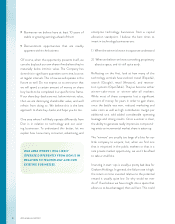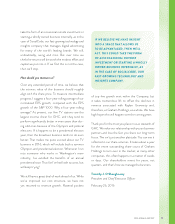Washington Post 2015 Annual Report Download - page 20
Download and view the complete annual report
Please find page 20 of the 2015 Washington Post annual report below. You can navigate through the pages in the report by either clicking on the pages listed below, or by using the keyword search tool below to find specific information within the annual report.Recent Federal Rulemaking
New Regulatory Initiative. In August 2015, the ED announced its intent to begin a new regulatory initiative to
determine the acts or omissions by a postsecondary institution that may be used by a borrower as a defense to
repayment of certain Title IV loans and the consequences of such borrower defenses for borrowers, institutions,
and the ED. In October 2015, the ED solicited nominees for negotiators to serve on a negotiated rulemaking
committee to develop proposed regulations to address (1) the procedures to be used by a borrower to establish a
defense to repayment; (2) the criteria that the ED will use to identify acts or omissions of an institution that
constitute defenses to repayment of Federal Direct Loans, including the creation of a Federal standard; (3) the
standards and procedures that the ED will use to determine the liability of the institution for amounts based on
borrower defenses; (4) the effect of borrower defenses on institutional capability assessments; and (5) other loan
discharges. In addition, the committee may also consider if and how these issues will affect loans made under the
Federal Family Education Loan Program. The negotiated rulemaking committee began a series of meetings in
January 2016 that are expected to conclude in the spring of 2016. The ED is expected to publish proposed
regulations that would be subject to notice and public comment and to publish final regulations by November
2016 that would take effect the following year. The regulations could include provisions that result in standards
and procedures for determining institutional liabilities for discharged loans and for imposing other sanctions on
institutions. The Company cannot predict the ultimate scope and content of the regulations, nor can it predict
their impact on KHE.
Final Regulations. In 2015, the ED issued final regulations that focused on Program Integrity and
Improvement requirements in the following areas:
• Cash management of funds provided under the Title IV Federal student aid programs, including the use
of debit cards and the handling of Title IV credit balances;
• Clock to credit-hour conversion;
• Books and supplies; and
• The application of the repeat coursework provisions to graduate and undergraduate programs.
Gainful Employment.Under the Higher Education Act, certain education programs are required to lead to
gainful employment (GE) in a recognized occupation in order to be eligible to participate in the Title IV
programs. In June 2011, the ED issued final regulations that tie an education program’s Title IV eligibility to
whether the program leads to gainful employment. On June 30, 2012, the U.S. District Court for the District of
Columbia vacated most of these final regulations.
The ED convened a negotiated rulemaking committee in September 2013 to develop new proposed GE
regulations. The final regulations were released on October 31, 2014, and generally became effective July 1,
2015. Among other requirements, each program subject to the GE regulations must meet one of two debt-to-
earnings rates, which compare Title IV-aided graduates’ payments on debt incurred to attend the program to their
annual earnings and discretionary income as defined and calculated in the regulations. The ED will calculate the
debt-to-earnings rates using income information obtained from the Social Security Administration, federal Title
IV loan debt information gathered from its own records and private loan and institutional debt data provided by
schools. If a program’s graduates’ median debt payments exceed 8% of the graduates’ mean and median annual
earnings and 20% of the graduates’ mean and median discretionary income, the program will be placed on a
warning status (referred to by the ED as “zone” status). If a program’s graduates’ median debt payments exceed
12% of the graduates’ mean and median annual earnings and 30% of the graduates’ mean and median
discretionary income, the program will fail the debt-to-earnings rates metric. If a program fails the test two times
within three years, it will become ineligible to participate in the Title IV programs for a period of three years. If a
program fails the test or is in the zone for four consecutive years, it will become ineligible to participate in the
Title IV programs for a period of three years. In addition, the regulation requires an institution to provide to
current and prospective students prescribed warnings of the potential ineligibility of the program in any year for
which the program could become ineligible based on a rate for the next year that is in the zone or failing.
5 GRAHAM HOLDINGS COMPANY
























